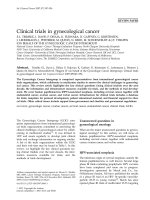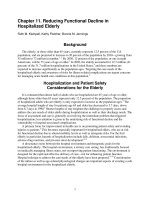TRENDS IN MATHEMATICAL PSYCHOLOGY ppt
Bạn đang xem bản rút gọn của tài liệu. Xem và tải ngay bản đầy đủ của tài liệu tại đây (20.28 MB, 493 trang )
TRENDS IN MATHEMATICAL
PSYCHOLOGY
ADVANCES
IN
PSYCHOLOGY
20
Editors
G.
E.
STELMACH
P.
A.
VROON
NORTH-HOLLAND
AMSTERDAM 'NEW
YORK'OXFOKD
TRENDS
IN
MATHEMATICAL PSYCHOLOGY
Edited
by
E. DEGREEF
and
J.
VAN
BUGGENHAUT
Centre for Statistics
and Operational Research
Brussels, Belgium
1984
NORTH-HOLLAND
AMSTERDAM.
NEW YORK
.
OXFORD
0
Elsevier Science Publishers B.V
1984
All rights reserved. No part
of
this publication may be reproduced.
stored in a retrieval system.
or
transmitted. in any form or by any means.
electronic. mechanical. photocopying. recording or otherwise. without the prior
permissionof thecopyright owner.
ISBN:
044
87512
3
Publishers:
ELSEVIER SCIENCE PUBLISHERS
B.V.
P.O.
Box
1991
1ocN)
BZ Amsterdam
The Netherlands
Sole
disiribur0r.r
for
the
U.S.A.
und
(briadu.
ELSEVIER SCIENCE PUBLISHING COMPANY. INC.
52
Vanderbilt Avenue
New York.
N.Y.
1OUI7
U.S.A.
Library
of Comgmm
Catmlogl~g
11
PmbUeathm
Datm
MBin.entry
under
title:
Trends in mathematical psychology.
(Advances
in
psychology
;
20)
Papers presented at the 14th European Mathematical
Ssychology
Group Meeting, held in Brussels, Sept.
12-14,
1983.
Includes indexes.
Psychometrics Congresses.
I.
Degreef,
E.,
1953-
TI.
Buggenhaut,
J.
van,
1937-
.
111.
European
Mathematical Psychology Group.
Psychology Group. Meeting (14th
:
1983
:
Brussels,
Belgium)
Netherlands)
4
20.
IV.
European Mathematicd'
V.
Series: Advances
in
psychology
(hterdam,
BF39.T74 1984
150'
.28'7 84-6032
ISBN
0-444-87512-3
(U.S.)
PRINTED IN
THE
NETHERLANDS
V
PREFACE
This volume gathers most of the papers presented at the 14th Eurooean Mathe-
matical Psychology Grouo Meetinq. The meeting took place in Brussels from
Sentember 12 to September 14, 1983 and was hosted by the Vrije Universi-
teit Brussel. Financial supnort was also provided b;y the pelqian "Natio-
naal Fonds voor wetenschanpeli jk Dnderzoek", the Belgian "tcinisterie van
Nationale Opvoeding", the EelFian "Culturele Betrekkingen" and the "Natio-
nale Bank van Belgie".
The idea of the Groun is to bring together once a year, neoDle in Europe
working
in
the field of Vathematical Psychology, Taken into account the
growing importance attached to mathematical models in human sciences, the
exaeriences acquired in Drevious meetings and the presence, besides other
we1 1-known participants,
of four invited lecturers, namely
S.
Crossberg
(Boston University), F.S. Roberts (Rutoers, State University of New Jersey)
and V.F. Venda
-
V.Y.
Krylov (Floscow,
USSR
Academy of Sciences), gave
us
the idea to make a selection of the contributions and to gather them
in
a
book.
In order
to
structure the whole, we took the liberty to groun the papers
into three parts, knowing that the classification can be discussed;
of the papers,
indeed, can find a place in more than one part.
find:
some
So
you
will
Part
I
:
Perception, learning and memory
Part
I1
:
Order and measurement
Part
111:
Data analysis.
ble hope that the studies collected here, fairly reoresent the different
perspectives and that the volume as a whole
will
be a dynamic resource for
those who want
to
keeD abreast of flathematical Psychology in general and
the Eurooean one in particular.
We finally wish to thank Francis Gheys for the excellent typing of the
manuscript.
It
was a lot
of
work, but we enjoyed
it.
The editors
Brussels
,
February 1984
This Page Intentionally Left Blank
Vii
CONTENTS
Preface
Parti cioants
v
xi
PART
I:
PERCEPTION, LFARNINI; AND
MEMORY
Tree renresentations of associative structures in semantic and
enisodi c memory research
11.
bbdi,
J P.
FivLRhUtrny,
Y.
Luong
Task-denendent representation of categories and memory-ouided
inference duri nq cl assi
fi
cation
H.
RU~~WL.~,
ti (;.
&?hAeet
Outline of a theory of brightness, color, and form nercention
s.
h044bUg
Attenti on in detection theorv
E.C.
b!icbo
Imnossible objects and inconsistent interpretations
E.
TLtoianne
In searching of general regularities of adaptation dynamics:
on the transformation learning theory
V.F.
Venda
A
Drohabilistic choice model adanted for the angle Dercention
experiment
N.P.
VenheL5.t
PART
I1
:
ORDER AND
MEASUREPIEKT
About the asymtries of similarity judgments: an ordinal noint
of view
J P.
Rah.thaePrnu
The axiomatization of additive difference models
for
preference
judgments
M.A.
Cnoon
1
3
33
59
a7
105
121
159
175
177
193
Viii
Contents
Generalizations of interval orders
1.
-7.
poiqnon
Reseaux sociaux generalises: en combinant graphes et hyperoranher
C.
FLnment
On conceots of the dimension of a relaticn and a generalized re-
copnition expcrimnt
K.
IJe?rh4t
Isotonic regression analysis and additivity
7.p.
‘Inc
Patiold
Testing Fechnerian scalability bv Faximum likelihood estimation
of
ordered binomial narameters
?.
“nt~64efd
Prnbahi listi c consistency, homoaeneous fami lies
of
re1 ations and
1
inear 1-re1 ati ons
B.
Vonjmdct
Aoplications
of
the theorv of meaninafulness to order and matching
exoeri men
ts
F.S.
Robem2
A
new derivation of the Rasch model
E.
E.
Ra.ikn~i,
P.C.W.
Jnmen
A
definition of partial interval orders
?I.
?oubeno,
Ph.
VLncke
Causal linear stochastic deDendencies: the formal theory
?.
Sfelreh
Factorization and additive decomposition of a weak order
”.
Suck
PADT
111:
DATA
ANALYSIS
The oroblem
of
representation based umn
two
criteria
G.
De
Ueut,
hl.
G~4ne~,
X.
HubaLLt
Tree representations of rectangutar proximity matrices
G,
Oe
Soete,
W.S.
DCa.tbo,
C.Pl.
FUMLU,
J.D.
CmoU
ifleak and strong
models
in
order to detect and measure ooverty
?.
Picken
209
2 19
227
239
25
5
271
283
293
309
317
347
363
365
377
393
Contents
ix
Am1
i
cations of a Bayes
M.G.f/.
Jan6en
The polychotomous Rasch
ses
an Poisson model for misreadings
model and dichotomization of graded resnon-
P.G.P!.
.TanAeen,
E.E.
Qobkam
Comnonent analysis of transition nrobabilities and its anolication
to prisoner's dilema
K.
Rainio
An anplication of mu1 tidimensional scaling on Drediction: the Radex
structure
F.
Van
OvWe
Author index
Subject index
405
413
433
449
473
477
This Page Intentionally Left Blank
xi
PARTICIPANTS
H.
ABDI,
Laboratoire de psychologie, Ancienne Facul
te,
Rue Chabot Charny,
21000
Di
jon
,
France
H.
ALGAYER, Donndorforstr. 93, D-8580 Bayreuth, Federal Republic Germany
J.
ANDRES,
Rathausstr. 53, 53 Bonn 3, Federal Republic Germany
J P. BARTHELEMY,
ENST,
Deoartement d'Informatique,
46
Rw
Barrault
75634 Paris Cedex 13, France
A.
BOHRER.
CRS,
Sectie voor Psychologisch Onderzoek, Kazerne Klein Kasteel-
tje, 1000 Brussel, Belgium
H.
F.
J
.M.
BUFFART, Psychologi sch Laboratori urn
,
Kathol ieke Universi tei
t
Nijmegen, Postbus 9104, 6500HE Nijmegen, The Netherlands
M.A.
CROON,
Katholieke Hopeschool Tilburg, Hogeschoollaan 225, Tilburg,
The Nether1 ands
E.
DEGREEF,
CSOO,
Vrije Universiteit Brussel, Pleinlaan 2, 1050 Brussel,
Belgium
L. DELBEKE, Psychologisch Instituut, Katholieke Universiteit Leuven,
Tiensestraat 102, 3000 Leuven, Belgium
G.
DE
MEUR,
Universite Libre de Bruxelles,
CP
135, 1050 Bruxelles, Belgium
G.
DE
SOETE, Dienst voor Psychologie, Rijksuniversiteit Gent, Henri
Dunantlaan 2, 9000 Gent, Belgium
M.
DESPONTIN,
CSOO,
Vrije Universiteit Brussel, Pleinlaan 2, 1050 Brussel,
Be1 gium
P.
DICKES,
Universite de Nancy 11, Bd Albert
I,
BP
3397, 54015 Nancy-Cedex,
France
J P.
DOIGNON,
Universite Libre de Bruxelles,
CP
216, 1050 Bruxelles,
Belgium
C.
FLAMENT, Departement de Psychologie, Universite de Provence, Les Blaques,
Cereste, F-04110 Reillanne, France
H G.
GEISSLER, Sektion Psychologie, Karl-Marx-Universitat Leipzig,
Tieckstr. 2, 7030 Leipzig, German Democratic Republic
M.
GASSNER,
Universite Libre de Bruxelles, CP 135, 1050 Bruxelles, Belgium
C.A.W.
GLAS, C.I.T.O., Postbus 1034, 6801
MG
Arnhem, The Netherlands
S.
GROSSBERG,
Center for Adaptive Systems, Boston University,
111
Cumington
Street, Boston, Massachusetts 02215,
USA
P.K.G.
GUNTHER, Siebengebirgstr.
11,
D-5330 Konigswinter 41, Federal Republic
Germany
M.
HAHN,
Mollwitzstr. 5, D-1000 Berlin 19, Federal Republic Germany
K.
HERBST, Institut
filr
Psychologie, Universitat Regensburg, Universitatstr.
31,
D-8400 Regensburg, Federal Republic Germany
D.
HEYER,
Institut
fir
Psychologie, Universitat Kiel
,
Ohlshausenstr. 40/60,
D-2300 Kiel
,
Federal Republic Germany
M.G.H.
JANSEN,
Instituut voor Onderwi jskunde, Rijksuniversiteit Groningen,
Westerhaven 16, 9718
AW
Groningen
,
The Netherlands
V.Y.
KRYLOV, Department of Mathematical Psychology, Institute
of
Psychology,
USSR,
Academy of Sciences, Moscow 129366, 13 Yaroslavskaya,
USSR
N.
LAKENBRINK, Auf dem Kampf
11,
D-2000 Hamburg 63, Federal Republic Germany
X.
LUONG, Laboratoire de Mathematiques, Universite de Besancon, Besancon,
France
R.R.
MAC
DONALD, Department of Psychology, University of Stirling, Stirling
FK94LA. Scotland
xii
Participants
A.W.
MAC RAE,
University of Birmingham, Box 363, Birmingham 615 ZTT,
Great Britain
R.
MAUSFELD, Universitat Bonn, Auf den Steinen 13A, 53 Bonn
1,
Federal
Republic Germany
H.C.
MICKO,
Institut
fur
Psychologie, Technische Universitat Braunschweig,
Spielmannstrasse 12A, 0-3300 Braunschweig, Federal Republic Germany
B.
MONJARDET, Centre de Mathhatique Sociale, 54 Bd Raspail, 75270 Paris
Cedex 06, France
C.
MULLER, Lehrstuhl
fur
Psychologie
111,
Universitat Regensburg, Postfach
397, D-8400 Regensburg, Federal Republic Germany
p.
PLENNIGER. Seminar
fiir
Philosonhie und Errichungswissensc5aft der Univer-
sitat Freiburg, IJerthmannnlatz, D-7800 Freiburo, Federal
Republic Germany
B.
ORTH. Institut fur Psychologie, Universitat Hamburg, Von-Melle-Park
6,
D-2000 Hamburg 13, Federal Republic Germany
M.
PIRLOT, Universite de 1'Etat
a
Mons,
17
Place Warocque, 7000
Mons,
Belgium
J
.G.W.
RAAIJMAKERS,
Psychologisch Laboratorium, Kathol ieke Universi tei
t
Nijmegen, Postbus 9104,
6500
HE
Nijmegen. The Netherlands
K.
RAINIO,
University of Helsinki, Petaksentie 44, 00630 Helsinki, Finland
F.S.
ROBERTS. Qutqers, State University cf f'ew Jersey.
Deep.
of 'lath. at New
Brunswick,
Hill
Center for the '4athematical Sciences, Rush Camous, New
Rrunswick, New Jersey
08903,
1J.S.A.
E.E.
ROSKAM, Vakgroep Mathematische Psychologie, Katholieke Universiteit
Nijmegen. Postbus 9104,
6500
HE
Nijmegen, The Netherlands
M.
ROUBENS,
Faculte Polytechnique de Mons,
9
Rue de Houdain, 8-7000 Mons,
Belgium
U.
SCHULZ, Fakultat fur Psychologie und Sportwissenschaft, Abt. fur
experimentel le und angew. Psychologie, Universitat Bielefeld, Postfach
8640,
4800
Bielefeld, Federal Republic Germany
A.J. SMOLENAARS, Psychologisch Laboratorium, Universiteit Amsterdam,
WeesDerolein
8.
1018
XA
Amsterdam, The Netherlands
R.
R.
E.
P.
J.
A.
A.
L.
F.
STEYER,' Fachbereich
I
-
Psychologie, Universitat Trier, Schoeidershof,
0-5500 Trier, Federal Republic Germany
SUCK,
Universitat Osnabruck, Postfach 4469, 45 Osnabruck, Federal
Republ ic Germany
TEROUANNE,
UER
Mathematiques, Universite Paul Valery, BP 5043, 34032
Montpellier
-
Cedex, France
VAN ACKER,
1
Chaussee de Wavre, 1050 Bruxelles, Belgium
VAN
BUGGENHAUT,
CSOO.
Vrije Universiteit Brussel, Pleinlaan
2.
1050 Brussel, Belgium
VAN DER WILDT,
CSOO,
Vri
je Universiteit Brussel, Pleinlaan
2,
1050 Brussel,
Be1 gi um
VAN
DINGENEN,
CSOO,
Vri
je Universi tei
t
Brussel
,
P1 einlaan
2,
1050 Brussel
,
Belgium
VAN
LANGENHOVE, Faculteit Psychologie
Brussel, Pleinlaan
2,
1050
Brussel, Belgium
VAN
OVERWALLE,
EDUCO,
Vrije Universiteit Brussel, Pleinlaan
2,
en Opvoedkunde, Vrije Universiteit
1050 Brussel, Belgium
J.C.
VAN
SNICK.
Facult6 des Sciences Economiques et Sociales. Universite de
1'Etat
a
Mons, 17 Place Warocque, 7000
Mons,
Belgium
V.F.
VENDA.
Department of Engineering Psychology, Institute of Psychology,
USSR
Academy of Sciences, Moscow 129366, 13 Yaroslavskaya.
USSR
R. VERHAERT,
CSOO,
Vrije Universiteit Brussel, Pleinlaan
2,
1050
Brussel,
Belgium
Participants
xiii
N.D.
VERHELST,
Subfacul teit der psychologie, vakgroep
PSM,
Ri
jksuniversi-
teit Utrecht, Sint-Jacobsstraat
14,
3511
BS
Utrecht, The Netherlands
Ph.
VINCKE,
Institut de Statistique, Universite Libre de Bruxelles,
CP
210,
8-1050
Bruxelles, Belgium
This Page Intentionally Left Blank
PARTI
PERCEPTION, LEARNING AND MEMOR
Y
This Page Intentionally Left Blank
TRENDS
IN
MATHEMATICAL PSYCHOLOGY
E.
Degreef and
J.
Van
Bu
genhaut (editors)
0
Elsevier
Science
Dublisfers
B.
V.
(North-Holland), 1984
TREE REPRESENTPTIONS
OF
ASSOCIATIVE STPUCTUpE5
IN
SFFWNTIC
AND
E
P
J
SOD1
C
VFF1ORY
RE
SF
ARCH
Herve Abdi
Laboratoi re de Ps.vcholoaie, Dijon
Jean-Pierre Barth12l&ny
F.PJ.q.T., Paris
Xuan Luona
Laboratoire de Mathematioues, Besanqon
lnle exnose some research in the area of psycholorry of
memory involvinq oroximitv or distance matrices.
nronose
some
ways of building
LIP
such ratrices. Then
we detail an alaorithm allowinc! the renresentation
of
proximity matrices
by
an additive tree, and contrast
this new aloori thm with orevious ones,
Final lv, we
examine
some
results obtained with th
1.
INTRODUCTION
The general ournose of this naner is to emphasize
3
s
method.
the utility and describe
the use of additive trees
in
order to describe data collected in the field
of the nsychology of Femory.
some
research leadino to the construction of distance or nroximity matrices;
secondly we expose and detail the construction of an additive tree as a re-
nresentation of the orioinal riatrix: finally, we examine the results obtain-
ed.
The utilization of clusterinq methods for attestina the oraaniration
of
memo-
rv or revealing its structure has been stronyly advocated recently by
some
authors in different areas of cognitive Fsycholooy (see, among others:
Mil
ler (1969)
,
Henley (1969), Friendly (19781, Rosenbera et a1 (1968)
,
(1972),
(1982)). Most of the used methods amount to renresent the original matrix
by an Ultrawtric Tree. Recently, there has been an attempt to build
sow
methods leading to renresentations less stringent than the classical U1 tra-
metric Tree,
i
.e. the Additive Tree (see Carroll
&
Chang (1973), Cunningham
(1974), (1978); Sattath
R
Tversky (1977)). Ye nronose hereafter an (econo-
mical) heuristic givina an Additive Tree from a oroximity matrix and illustra-
te
it
with
some
examples borrowing from our current research or from classi-
cal oaners.
This naner is threefold: we first describe
4
H.
,4bdi,
J P.
Burthhlhmy
und
X.
Long
2.
A
RUNCH
OF
EXAWLES
2.1.
RAPTLET':
:
"'il'f
TC
THE
GHOSTS"
In
1932,
Rartlett asked
i:
few suhdects to read an lrwrican Indian folk
tale
(named "The
'.tar
of the chosts"! and to recall the storit on reveral occasions
(a
wthod called "rerleatec' renroduction"); in
a
variant of the method (i.e.
"yerial
renroduction")
a
chain of different suhiects
is
used, the first
heinq
shown the oriclinal text and then recallinn for the second subject who
would nass
it
to
a
third and
so
on. These classical exneriwnts
of
Partlett
will
serve here
to illustrate a set of informatic nrocedures, the aim of
which is to build
sow
distances hetween texts.
")
Infomatic orocedurw
For reasons of compatihilitv, the nroorams are written in Standard Vicrosoft
Pasic (Vnder
CPp),
and at least
64
K-Bytes of
RAP1
and a disk Unit are need-
ed. Although these nronram include
some
various nossihilities, we
will
re-
strict ourself to the nart dealina snecifically with the construction
of
metri
cs between texts.
It
must be clear that when we sneak of the text oiven by a subiect, we
could sqeak as well of a set of themes or ideas
aiven by a suhdect Drovi-
dino an adequate codinc; of the raw data.
The texts are first transfomd in a disk file, then for each text we build
the Lexicon associated with
it.
This Lexicon could be either a Boolean
Lexicon
(i
.e.
it
rnerelv indicates the Presence or the Absence of the item
of
Vocabulary) or
an
inteoer Lexicon (i.e.
it
indicates the numher of Occur-
rences of each item). From the diCferent Lexicons (Boolean
or
Integer) we
build
-
by union
-
a General Lexicon that defines the Vocabularv shared hy
the different texts.
R)
Construction of distances hetween texts
knendinq
on
the point of view adonted, we could define different distances;
as an illustratios we examine three ways:
(i\ the texts as suhsets of the Vocabulary
(ii) the texts as Ri-oartitinns of the Vocahularv
(ii
i
)a "orobabi 1 is
ti
c"qenera1itation.
Dpncte
by
Li
the Lexicon associated with a text Ti, the aeneral Lexicon hy
V
=
0
Li. and
by
the comlement of Li
in
V.
i
Tree representations
of
associative structures
5
(i)
for examnle
,
the we1 1-known distance between sets
,
the
so
called cardinal
of the symmetric difference:
Each (Boolean) Lexicon* is a subset of the Vocahularv and we could use,
d(Ti,Tj)
=
ILi
A
Ljl
=
ILi
nnl
+
lEn
Ljl.
(ii) {Li,E} defines
a
Ri-Partition of
V
(i.e. a Partition with two classes),
and so does {Lj,al.
So,
we could use
sow
distances between Partitions
(cf. Arabie
&
Roorman
(1973))
or Si-Partitions,e.q. the distance of the
symmetric difference hetween 'i-partitions that can be expressed as:
d(Ti,Tj)
=
2(
lLinLil+lEqnl)( lLi~~l+lEnLjl)
=
2(
lT"Kil)(
ILi ALj
I
)
(iii) In order to take exnlicitly account of the Integer Lexicons we could
look for an extension of (i).
measure on
V
(i .e. the frequency of the different words); denote the pro-
bahility of item x
of
text Ti
by Pi(x);
then we find
a
family
of
distances
Ielith each Ti is associated a probability
by
d,(Ti
,Tj)
=
c
[Pi(x)-Pj(x)I?
*V
2.2.
FFnTLJRES
OF
PFRSONALITY
This research lays on the border between the work on the oroanization of the
semantic memory and the work unon the "implicit Dsycholoqy".
The ourpose is
to describe the subjective orsanization of the qualifiers
of
the character.
As
a matter of fact,
it
has often been noted that we
tend to qroup subjec-
tively
some
features of character as
if
we has an "Imolicit Theory of Per-
sonality" (cf. e.a., Rosenherrr et a1 (1972), 'Veoner and Vallacher (1977)).
In this experiment we select
fifty
eiqht qualifiers
of
the character (usina
some Thesauruses and a bit
of
literature,.
).
These qualifiers are then
orinted on seoarate cards and aiven individually
to
twenty-eioht subjects
with the request
that
he or she sort the cards into Diles with the constraint
that "the cards in a same wile give the feeling to
no
tooether"; subjects
were free to choose the numher of Diles for sortinn (for a review
of
the
pro and contra of the sortina method, see Rosenbern (1982)).
Notice that one could
"
fuzzy
"
the "boolean" distance in
(i)
and (ii) by
taking the fuzzy equivalent
of
the union and intersection,i .e. Min and Max.
*
6
H.
Abdi,
j.2.
Borthdl6my
and
X.
Luong
Hence, each subject exoresses his oninion
by
a
nartition
on
the set of the
nualifiers,
and
for usino
as
a
0-rlethodoloay (cf. Kerlinoer (1973)) the
afore evoked distances between nartitions could easily be used. The
parti-
tion
given
by
a
subject is associated with
a
matrix whose rolls
and
columns
ren-esert the Qualifiers,
and
where we
put
a
1
at
the intersection of
a
row
and
a
column
if
the nualifiers are not sorted
in
the same nile
by
the sub-
iect. Obviously this is
a
distance matrix (cf. Wller
(1969)\,
and
so
will
he
the matrix definetiby the sum
of
the matrices
of
tbe
different subjects.
In
this matrix we simnly count the number of suhjects
who
do
not
nut
tooe-
ther the qualifiers.
by
the sum
of
the so-called incidence
matrix
(where
a
1
means
t+at
the
qua-
lifiers are
in
the same nile),
fnr
commodity reasons this is the
matrix
we
qive later (cf. Table
3).
It
must be noted, in nassinq,
that
the
Data
obtained
and
consenuently the
distance matrix denend
uoon
the
wthods
desinned
for
obtaininn
such
Data.
In
narticular, other wthods (e.0. word associations,
or
distances between
words in free-recall, etc.) lead to other results (see Pbdi (1383)).
2.3.
OLRIEP
RUT
<OLPIE5
Tt
could be useful
to
comnare different methods
on
well-known
data.
Isle will
examine here three sets of data (included
two
"classics").
The first comes from
a
study
by
fiiller
(1969)
nioneerinn the structure of
semantic memory.
cording
to
their similarity
of
waninq (the suhjects were qiven
a
brief
definition of each
noun
taken from
a
dictionary). The co-occurence matrix
(similar
to
the
matrix
Dreviously discussed, cf.
2.2)
was subjected
to
hierarchical clusterinn usinq Johnson's (1967) connectedness
and
diarceter
mthod.
These results are recalled
in
4
(cf. Table
4
and
Fioure
5).
The second is extracted from
a
study conducted
bv
Henlev (1969).
tained from twenty one subjects
an
estimation of the distance between twelve
animal
terms (for each subject she simoly counts the number of terms sepa-
rating
the terms
of
interest
in
a
list given by the subiect nrovided
with
the instruction
to
"list all the animals thev could");
the matrices are
then standardized
and
the
mean
for
each cell (e.4. across subjects) give
the entrv
of
a
dissimilarity matrix.
Finallv, Friendly
(1979),
in
a
naoer akind
to
the
two
orevious ones,
Pually vie could have
&fired
a
matrix
of
co-occurences
Fiftv college students, each sorted fortv-eiaht words ac-
She
oh-
Tree representations
of
associative structures
7
stroncrly advocate the use of hierarchical clusterin? to diaaram the memory
orpanization.
except that the orioinal data came from free recall exDeriments. The data
were "a nriori" orqanized in three subsets: animal terms, narts of the huran
body, vegetables. The air of the study was the recovery of this a Driori
structure (cf. Rousfield (1353)
,
Tulving (1972)).
He nronosed a nroxirity matrix ohtained sonwhat like Henley
3.
PlETHnDS
Proadly sneaking, the methods dealinn with Droximitv data can he divided
under two aeneral categories: The rlans and the Cranhs.
The llaps encompass
-
in narticular
-
the different variants of hltidiwn-
sional Scalina (cf. Kruskall (1978), Ychiffman et a1 (19811, Young et al,
to annear), Ootimal or Dual Scaling or Corresnondence Analysis dependina on
the authors (cf. Benzecri (1973),
Hill
(1974), Nishisato (1980)) or classi-
cal scalina or "trinle malvsis"
if
the proximity could he judqed as dis-
tance (Toraerson
(
1958)
,
Renzecri (1973)
)
.
The aeneral characteristic ofthe Graohs is to represent the ohiects as ver-
tices and the Droxirnity (or the distance) between them by arcs (with or
without valuation).
qraohs by looking for the connected comDonents, or its centroid (cf. Abdi
(1980)) or by imposina
some
threshold for drawing the arcs between vertices
(cf. The Analysis of Similitude
developed by Flament et a1 (1962), and
Degenne and Verges (1973)). One can eventually imnose
some
restrictions on
the Sranh, i.e. beinq a tree. bfe detail this point in a moment.
3.1.
TRFFS
A
qeneral definition of a Tree can be a cycle free, connected, undirected
aranh; for convenience assume a valuation on the edqes, and define the dis-
tance between two vertices as the lenath of the nath from one vertex to the
other.
The Ultrametric Tree could he characterized
-
besides other conditions
-
by
the classical
"
ultrametric inequality". Three vertices
-
say x,y,z
-
on
an Ultrametric Tree verify:
One could nossibly explore the structure of these
d(x,y)
s
Flax [d(x,z)
,
d(y,z)I
.
This nroDerty is quite drastic and barely verified by similarity measures
obtained from an exDeriment (see Yiller
(1969)
for a stimulatinq discussion).
8
H.
Abdi,
] P.
Bartliildmy
and
X.
Luong
So
the nroblem is to huild un the hetier uitrametric annroximation of a
ci-
ven similarity
(cf. <neath and 5okal (1973), Hartigan (1971)). Instead of imnosin? the
ultrawtric inequality on the renresentation of
a
dissimi1arit.v (or distance)
matrix,
some
authors have nronosed to weaken the ultramtric inequality in
order
to
obtain a mre oeneral and more natural reDresentation (cf. Carrol
and Chano (1973), Cunnincham (1?174),
(1978)
;
Sattath and Tverskv (1977)
cal1c.C' following the authnrs
we?
rlhtcd tree, free tree, nath length tree or
unrooted tree (cf. amonn others: Cicrr'an
(1958)
,
Fakami
and
Val!
(1964)
,
nuneman (1971),
Dobson
(1974)).
following ineouality, holdinq for every four-unlet
-
say x,y,u,v
-:
d(x,y)
t
d(u,v)
s
'lax [d(x.u)
+
d(y,v); d(x,v)
+
d(y,u)l
.
It
can
be shown that the ultrametric inequality is stron?er than the addi-
tive inequality which, in turn, imolies the triangle ineouality.
The
algorithms for fittinrl an additive tree to a nroximitv matrix are less
numerous than those desioned for the saecies ultrametric tree. The construc-
tion of the additive tree can be seaarated (for the clarity of the exolana-
tion) into two parts:
1)
the finding of the tree-structure
(we
darc!
not
use
the
term skeleton
)
2)
the estimation of the valuation of the branches of the tree.
The classical apnroach (as illustrated by Cunninqham (1974), (1978);
Sattath and Tversky (1977)) makes a direct
use
of the additive inequalitv
for the finding of the tree-structure, and then estivates the valuation
with
a least-square method. For our nart,
we
pronose another anproach that
we
detail in a moment and contrast with the classical one.
3.2.
CONSTR!KTION
Or
TIIE
:REF
STRUCTURE
(A)
of "loose cluster".
matrix, and
a
lot
of
alaorithms are availahle for this
joh
This kind of a tree is characterized by the
Sattath and Tversky (1977) introduced
-
in a seminar naner
-
the notion
Let
E
he
3
set
and
r'
a dissimiTarity function defined
on
E
x
E,
hereafter
denoted as (E,d).
A
suhset
A
from
E
is a loose cluster
if,
for all {x,y}
from
A
and for all (u,v} frov
E
(with
x+u, x+v, ypu, ypv), the following
inenuality is verified.
d(x,y)
t
d(u,v)
<
flin Id(x,u)
+
d(y,v); d(x,v)
+
d(.v,u)l
.
(1)
If
E
corresponds
to
the terminal vertices
of
a tree, then the following
Tree
representations
of
associative structures
9
inequalitv holds for all four-unlet (x,y,u,v):
d(x,y)
+
d(u,v)
i
d(x,u)
+
d(y,v)
s
d(x.v)
+
d(v,u)
(or any of the five inequalities that can he
deduc?d from this
mutation).
Then
if
{x,yl is a loose cluster on a tree, from
(2)
and
(1)
fo
d(x,y)
+
d(u,v)
<
d(x,u)
+
d(y,v)
=
d(x,v)
+
d(y,u)
So,
in
the followinp tree with terminal vertices x,y,u,v
Y
(2)
one by per-
1
ows
:
{x,y} on the one hand, and {u,vl on the other are loose clusters, and
(2)
is then defined.
In oarticular, x and
y,
u and v are to adont the follo-
wino confiyration and are said
to
merge.
Converssly, knowinp that x,y,u,v coulr' be reoresented
hv
a tree, we get
only four Dossihle cases:
Y vu vv uu
V
(a)
(b)
(c)
(4
Here, the knowledce of a loose cluster is sufficient to characterize fully
the renresentation.
(i)
If
at least one Dair is loose then:
(x,y} loose
0
Iu,vl loose
*
tree a
{x,u} loose
*
{y,vj loose
*
tree b
{x,v) loose
4
{y,u} loose
*
tree
c
(ii)
No
oair
is
loose, and then we get the tree d.
These previous remarks could he used
in
order to huild the tree structure
fitting a (E,d).
For each
{x,Yl
from
E
the Sattath and Tversky's algorithm counts the number
L
10
H.
Abdi,
J R
BarfkiEmy
ad
X.
Luong
of pairs {u,vl verifyina
(1);
call this number the score
of
t!:e pair
{x,!!).
The algorithm then merges the hishest score nair
-
say x,y
-
into a new ele-
ment
-
say
z
The dissimilarity between
z
and the remainin? elements is
simply obtained by the average
of
the dissimi1arit.y of x,y.
then reiterated until1 all elements have been merced.
It
can easily be
verified that this aloorithm gives the exact tree of (F,d)
if
it
exists,
nroviding that the interior vertices of the tree are of decrree
3.
(B)
first give
some
definitions.
(i) Scoring subset and score.
G!e use the same notations
as
before. Let k be an inteper less than the car-
dinality
of
E.
Then we sa.v
that
x,y from
S
the followinp inequality holds:
The process is
{a,bl is element
of
E
x
E,
and
F*
=
F.
-
{a,bl.
a k-subset
-
say
S
-
of
E*
is
a scoring subset for (a,bl
if
for all
d(a,b)
t
Max d(x,y)
<
rlax[d(a,x)
t
d(,hy)l
.
The number of k-scoring subsets for the pair {a,b) is called the k-score of
{a,bl and is denoted k-Sc(a,b).
Let
(
E,d) be an additive tree and k equal to
2.
distance gives to every branch of the tree the length
1.
the:
The so-called canonical
tlw
we can give
Prooosi tion:
If
the canonical distance between trio terminal vertices
-
say a,b
-
is
two,
then k-Sc(a,h) is maximal
and k-Sc(a,u)=k-Sc(b,u)
for every
u
of
E.
The proof is left to the reader, but can eventually be found in Luong
(1983)
with
some
other prooerties
of
the scores.
(ii) Construction
of
the tree structure.
Set k=2.
compute then a score matrix. Me look for the pair with the maximal score
-
say a,b
-,
then we merne a,b to Five c and we Dose:
For every pair x,v we count the number
of
scorina subsets.
Me
k-Sc(c,u)
=
[k-Sc(a,u)tk-Sc(b,u)l
/
2
,
The nrocess is then reiterated until all the remaining elements have been
merged. This procedure is justified by the orevious nroposition. Notice
in nassing that we could straightforwardly extend this Drocedure to any k
(cf. Luong
(1983)).









